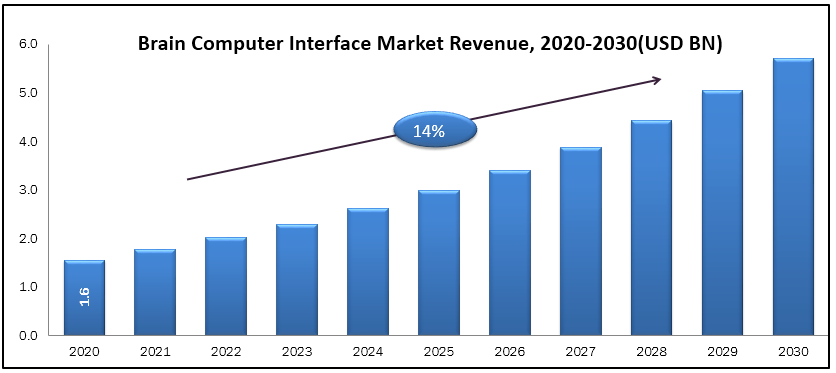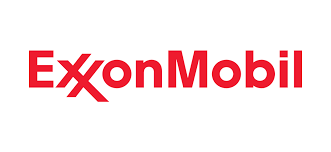Brain Computer Interface Market size accounted 1.55 billion in 2020 is estimated to reach 5.7 billion by 2030 growing with a CAGR of 14.0% during the forecast periodA Brain Computer Interface (BCI) is a computer based system which receives brain signals, analyzes them and translates them into commands, which connected to carry out a desired action. Researchers use it to help measure high and intense brain activities. A brain–computer interface (BCI) measures activity of the central nervous system (CNS) and converts it into artificial output that restores, replaces, enhances improves natural CNS output, and hence changes the ongoing interactions between the CNS and its external or internal. It is also used to measure the differences in voltage between the neurons to decide where the electrodes should be placed for the clearest signals. An example of this is controlling a prosthetic limb or arm. The approx costs of noninvasive BCI systems range up to USD 5,000- 10,000).
Market Segmentation:
On the basis of type, global brain computer interface market is segmented into invasive BCI, non- invasive BCI, and partially invasive BCI. By application, the market is divided into Restoration of disabilities, Repair of brain function, and Others. On the basis of technology, the brain computer interface market is classified into bit brain, brain up, emotive, electroencephalography (EEG), direct neutral interface (DNI), and Synthetic telepathy interface (STI). By end users, the market is classified into medical, military purposes and others. On the basis of region, the brain computer interface market is divided into North America, Europe, Asia Pacific, and RoW.
Market Dynamics and Factors:
Various technological advancements in the field of human-machine sensing, application of BCI technology in entertainment, smart home control, gaming and communication & control, rise in use of BCI technology in the healthcare sector are some of the major factors that are driving the brain computer interface market. Intensive research carried out to develop a cure for fatal brain disorders and injuries is expected to boost the brain computer interface market. However, ethical problems faced during research and cyber security threats are anticipated to restrict the brain computer interface market growth. On the contrary, integration of AI with BCI, and rise in demand for BCI by SMEs provide lucrative growth opportunities for the global brain computer interface market during the analysis period.
Geographic Analysis:
North America dominated the brain computer interface market in 2019 in terms of revenue, primarily due to high R&D investments and a large number of clinical trial being conducted on brain devices in the region. In addition, rising incidences of neurodegenerative conditions such as Parkinson's, Alzheimer's, and Huntington's disease are expected to drive the regional market growth. Rising demand for gaming is expected to lead to the development of technologies such as increase the brain computer interface, which boosts the adoption of BCI technology in the region. Asia Pacific is expected to register with the highest growth rate over the forecast period. Rising healthcare expenditure and growing awareness amongst patients about BCI are expected to drive the demand for brain computer interface in this region. Moreover, low cost manufacturing sites and favorable taxation policies in this region have attracted foreign players to invest in this lucrative market. Intensive R&D for BCI systems led to the launch of several innovative products.
Competitive Scenario:
Some of the key players operating in the global brain computer interface industry are Advanced Brain Monitoring, Inc., NeuroSky, OpenBCI, Cortech Solutions, Inc., Emotive, Natus Medical Incorporated, Integra Life Sciences, NIHON KOHDEN CORPORATION, and Cadwell Industries, Inc.
Brain Computer Interface (BCI) Market Report Scope
| Report Attribute | Details |
| Analysis Period | 2020–2030 |
| Base Year | 2021 |
| Forecast Period | 2022–2030 |
| Market Size Estimation | Billion (USD) |
| Growth Rate (CAGR%) | 14 % |
|
| By Type (Invasive BCI, Non-Invasive BCI, and Partially Invasive BCI), By Application (Healthcare, Communication & Control, Smart Home Control, Entertainment & Gaming, and Others), By Technology (Bit Brain, Brain UP, Emotive, Electroencephalography (EEG), Direct Neutral Interface(DNI), and Synthetic Telepathy Interface (STI), By End Use (Medical, Military, and Others) |
| Geographical Segmentation | North America (U.S., Canada, Mexico) Europe (UK, Germany, Italy, France, Rest of Europe), Asia-Pacific (China, Japan, India, Australia, Rest of APAC), South America (Brazil, Argentina, Rest of SA), MEA (UAE, Saudi Arabia, South Africa) |
| Key Companies Profiled | Advanced Brain Monitoring, Inc., NeuroSky, OpenBCI, Cortech Solutions, Inc., Emotive, Natus Medical Incorporated, Integra Life Sciences, NIHON KOHDEN CORPORATION, and Cadwell Industries, Inc. |







